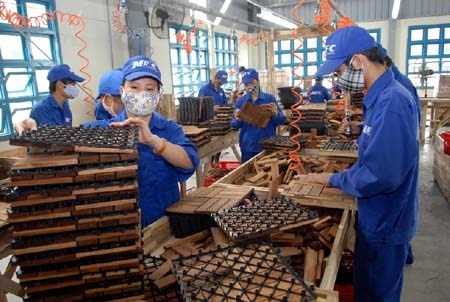Timber industry may flounder later in year
Vietnam's wood industry gained growth in its export value in the first seven months of 2015 but will have difficulty maintaining this growth until the year end, according to experts.
 Timber industry may flounder later in year (Photo:baotintuc)
Timber industry may flounder later in year (Photo:baotintuc)The General Department of Customs reported the industry had gained a year-on-year increase of 8.4 percent in total export value to reach 3.7 billion USD. The US, Japan and China were the three largest export markets for Vietnamese wooden products, accounting for 66.3 percent of the total export value.
Nguyen Ton Quyen, deputy chairman of the Vietnam Wood and Forestry Product Association, said the domestic wood industry has achieved strong growth since 2000, seeing a surge in total export value from 294 million USD in 2000 to 6.2 billion USD in 2014, with an average growth rate of 15 percent each year.
This year, the industry expects to gain a total export value of 7.2 billion USD, Quyen said, and Vietnam will become the fourth largest exporter in the world market, after China, Italy and Germany.
The good results for exports are attributable to the high quality of the wooden products which were processed from legal timber, he said. Over the past year, many wooden product importers have ordered Vietnamese wooden products instead of importing from China due to the high labour cost in China .
Local enterprises have made use of this advantage to expand their export markets, increase production capacity and produce value-added products from local materials, Quyen said.
In addition, high demand on the world market and free trade deals are expected to increase chances for local wood producers to further expand their export market, he said.
Demand for wooden products in traditional markets, such as the Republic of Korea and the European Union, and also in large markets, such as the US and Japan, increased during the first seven months of this year.
So far, many local producers have signed contracts to produce more goods by the end of this year, he said.
In the near future, the top five export markets for Vietnamese wooden products would be the US, Japan, China, the RoK and the European Union, Quyen said.
However, enterprises continue to face many challenges in achieving further growth in exports, such as the complications of exchange rates and the unstable supply of raw materials.
Phi Manh Cuong, deputy general director of Vietnam Forestry Corporation (Vinafor), said the European Union is one of the country's largest export markets but the reduction in the value of the EUR price has made foreign importers cut imports of Vietnamese wooden products and has even forced local exporters to reduce their price.
Meanwhile, the rising value of the US dollar has driven up the cost of imported raw materials, he said, noting that local producers import 70 percent of their raw materials, so enterprises have made little profit or even suffered losses.
In addition, input costs of coal, electricity and water continue to rise. As a result, Vietnam's wooden products are at a disadvantage compared to products from other countries, such as Myanmar, Malaysia and Indonesia.
Quyen said the agricultural ministry has developed forests to ensure an adequate supply of raw material.-VNA













